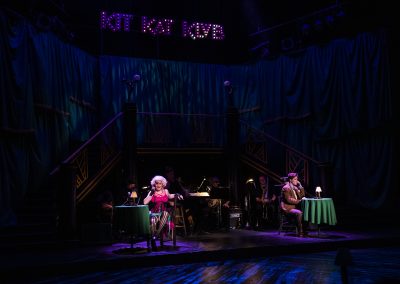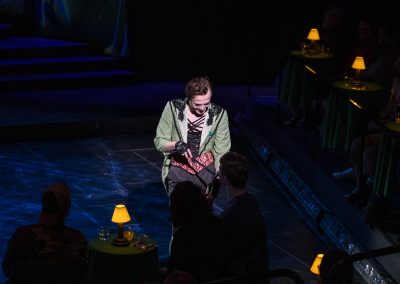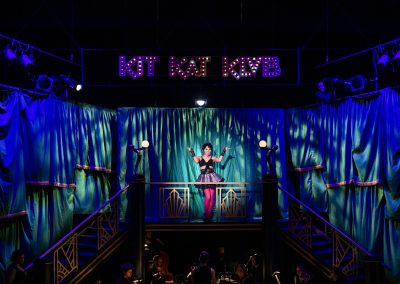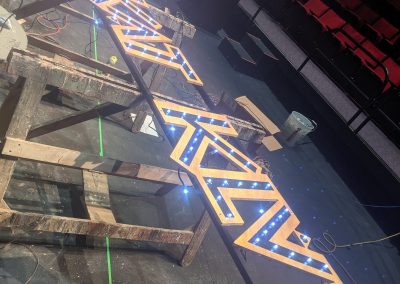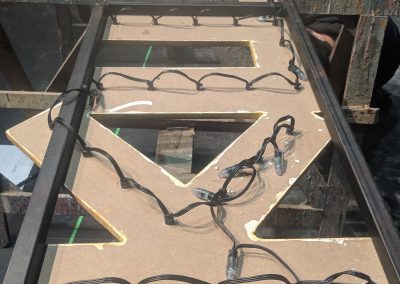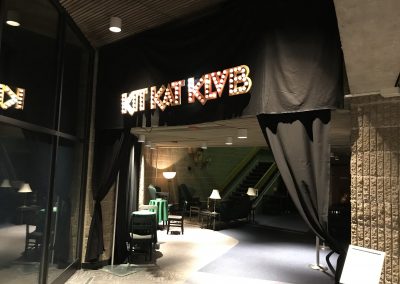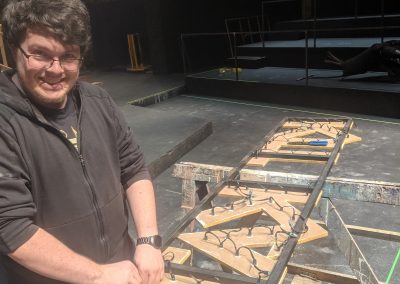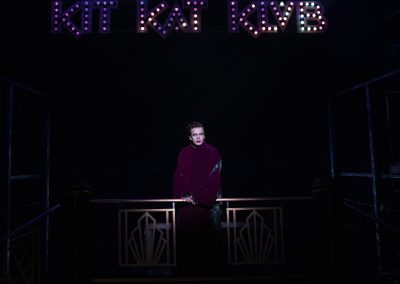Cabaret has been a favorite on the stage – and on screen – since it debuted in 1966. When Theatre UNI brought Cabaret to their stage at the University of Northern Iowa, they turned to gear from RC4 Wireless to help them achieve their vision. “I had used RC4 products on a handful of shows in the last 3 years and each of those experiences had gone incredibly smoothly,” states Cabaret’s Assistant Lighting Designer, Devin Schupp.
The production required a plethora of wireless gear. Schupp continues: “We had a few different set pieces which contained a practical light fixture on them – this included two Kit Kat Klub tables each having a small table lamp in the center, a floor lamp for the interior of a boarding house, and a cue light that was part of a dressing room mirror for a Klub performer. All of these items were constructed with some variation of either 12V LED tape or individual diodes. Each of these set pieces was carried or rolled on and off the stage for particular scenes. Due to the desired fast pace of scene changes, and the huge amount of dancing in the show, it would not be very practical at all to have these as hard-wired pieces.”
The lamps and mirror lights were fairly straightforward in terms of wireless dimming and DMX. However, there were other show requirements that weren’t quite so simple. “We decided to construct three large ‘Kit Kat Klub’ signs; one for the stage, and one for each end of the building’s lobby. These signs consisted of individual LED pixels spaced out through the letters, similar to a marquee style. We wanted individual pixel control and the ability to play selected media content on the signs. Due to the layout of the facility, the two lobby signs had to receive data from the console wirelessly; there simply was no other option. Additionally, the wireless signal to the lobby would have to pass through tons of concrete and steel in order to get through the walls and to the lobby.”
For the lamps and mirror lights, the team, led by Lighting Designer Chris Wood, used RC4 Wireless 2.4GHz products, including a DMX2dim, DMX4dim, DMX4dim-500, DMX6dim with a 2.4GHz transceiver. However, for the signs located in the lobby that had to transmit through concrete and steel, the team used RC4’s 900MHz DMXio transceiver with a 900MHz DMXpix. “The 900MHz equipment made it possible to transmit through the walls and out to the lobby. Everyone on our team was thoroughly impressed with the 900MHz range of products. We were transmitting moving media content through an incredible amount of concrete and steel, and these products handled it with no lag or problems at all,” Schupp explains.
In terms of programming the furniture items, “The process was an incredibly simple ‘plug and play’ situation. The RC4 receiver was connected to the power source and the light fixture and patched into the console and written into the cues just like any other standard dimmer. No additional configuration of the receivers was required,” says the Assistant Lighting Designer.
For the Kit Kat signs, “Programming was a little more of an involved process, but very quick to pick up on. Due to a limitation of available DMX addresses, we were not able to give a unique address to every pixel in both of the lobby signs. The DMXpix has the ability to keyframe the output, which essentially repeats the address values after a certain number. For these signs, ‘pixel #1’ would be both the first pixel in the chain, as well as the next one after the midpoint. This allowed the signs to only require half the amount of DMX addresses, giving us the ability to fit both signs into the same DMX universe. The RC4 Commander software makes this process incredibly easy to figure out and fine tune to your specific needs,” Schupp explains.
The entire Cabaret team worked with the RC4 equipment on site. “Shawn Poellet [Master Electrician], Nate Brock [Asst. Master Electrician], and Alex Drelich [Asst. Master Electrician] worked together to add the lighting components to the furniture pieces, build the Klub signs, and wire all of the RC4 gear into everything,” comments Schupp.
Overall, Schupp has had positive experiences with RC4 wireless products. He explains: “Every time I have used an RC4 product, I’ve been incredibly pleased with the results; RC4 products are made for anyone. If someone simply needs a wireless dimmer — say for a handheld lantern — they just need to plug everything in, and they’re all set to go; no additional configuration is required. Opposingly, if someone needs a wireless pixel driver and has restrictions that may require advanced configuration of the receiver, those advanced capabilities are present and can be configured in a user-friendly manner.”
Schupp concludes: “RC4 products are easy to incorporate into numerous projects that can add pleasing details to any production. It is incredibly easy to get started with, and also allows for some more complex configurations for those who need it.”


